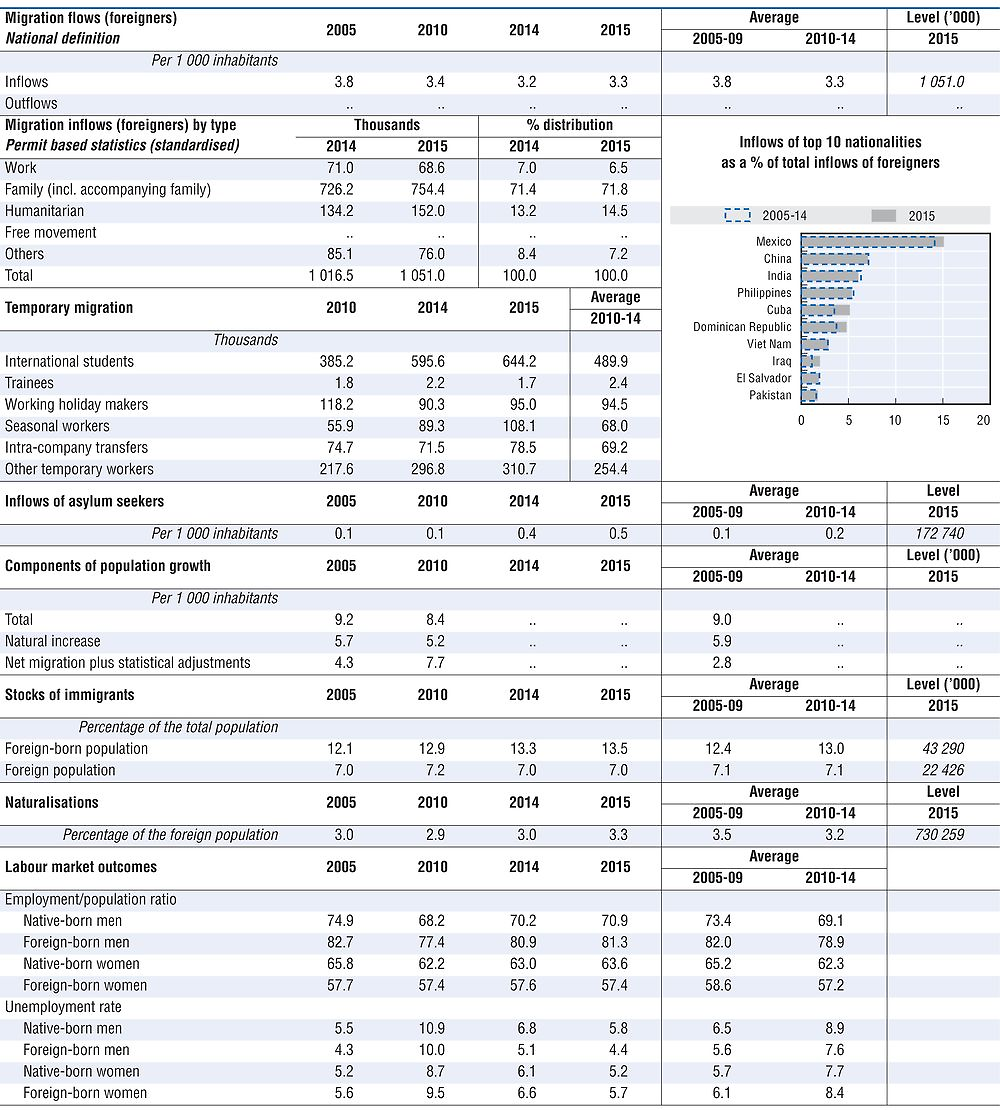United States
The number of persons granted Lawful Permanent Resident (LPR) status in the United States increased 3.4% from 1 016 518 in fiscal year 2014 to 1 051 031 in 2015, and more than half adjusted status from within the country. Unless otherwise noted, all references to years in this report are to fiscal years; fiscal Year 2015 began 1 October 2014, and concluded 30 September 2015
The total foreign-born population residing in the United States in 2015 totalled 43.3 million, or 13.3% of the U.S population. Individuals born in Mexico accounted for 27% of the foreign-born population, followed by India (5.5%), the People’s Republic of China (4.8%), and the Philippines (4.6%). These four countries accounted for approximately one-third of all persons granted LPR status over the past decade. The share of Asians among those granted LPR status increased from 35 to 40% over the last decade.
Family-sponsored immigrants accounted for 65% (678 978) of all persons granted LPR status in the United States in 2015, while 14% (144 047) of new LPRs were employment-based, and 14% were granted refugee status or asylum, including accompanying family members. The diversity visa program accounted for 5% of LPRs. The number of refugees adjusting to LPR status increased 23% between 2014 and 2015, primarily due to an increase in the number of Cubans adjusting in 2015 who entered in prior years. The numbers of immigrants in other visa categories were comparable to 2014 levels.
A total of 69 920 refugees were admitted in 2015 – virtually unchanged from 2014. Burma (18 386), Iraq (12 676), Somalia (8 858), the Democratic Republic of Congo (7 876), and Bhutan (5 775) were the leading countries of origin for resettled refugees; no other country accounted for more than 3 500 refugee admissions. A total of 26 124 individuals were granted asylum in 2015. This figure includes 17 878 individuals who were granted asylum affirmatively by the Department of Homeland Security and 8 246 individuals who were granted asylum defensively by the Department of Justice. The leading countries of origin for asylees were the China (6 192), El Salvador (2 173), Guatemala (2 082), Egypt (1 666), and Honduras (1 416).
Apart from short-term visitors, the leading categories of non-immigrant admissions were temporary workers and their families (3.7 million admissions), students and their families (2 million), and exchange visitors and their families (600 000).
A total of 783 062 people filed petitions to become US citizens in 2015, similar to the annual average for the preceding decade. These petitions led to 730 259 naturalizations, also near the ten-year average (762 249), but up 12% from 2014. Mexican nationals had the most applications for naturalization granted (105 958), followed by Indians (42 213), Filipinos (40 815), and Chinese (31 241).
In recent years, the Obama Administration announced a number of immigration policy changes through the U.S Department of Homeland Security (DHS). These administrative actions included the proposed expansion of the 2012 Deferred Action for Childhood Arrivals (DACA) program and the proposed Deferred Action for Parents of Americans and LPRs (DAPA) program, which were blocked by a federal court. Other administrative actions effected through DHS included granting work eligibility to the spouses of certain temporary workers, extending post-graduation employment opportunities for certain foreign students, clarifying eligibility rules for intra-company transferees, and permitting greater employment mobility in certain circumstances for those with pending LPR applications. Some of these actions are under challenge in federal court. DHS is currently reviewing the prudence and lawfulness of all of these administrative actions.
A one-time cap exemption was made by Congress in Fiscal Year 2016 for the H-2B non-agricultural temporary worker program: The cap for the H-2B programme remained at 66 000, as in previous years, but an exemption was made for “returning workers” who had participated in the H-2B programme in the three previous Fiscal Years. This exemption has since expired.
Earlier this year, President Trump issued a number of executive orders affecting immigration policy. These include orders strengthening border security, strengthening enforcement of the immigration laws, and improving the screening of foreign nationals seeking admission to the United States.
For further information
www.dhs.gov/immigration-statistics
www.uscis.gov/tools/reports-studies/immigration-forms-data
http://travel.state.gov/content/visas/english/law-and-policy/statistics.html
www.foreignlaborcert.doleta.gov/
www.ice.gov./removal-statistics/

